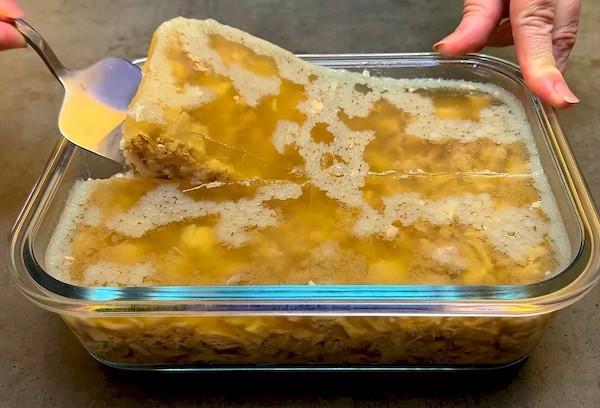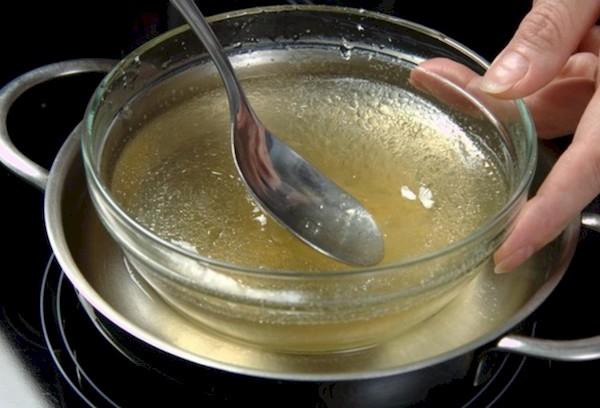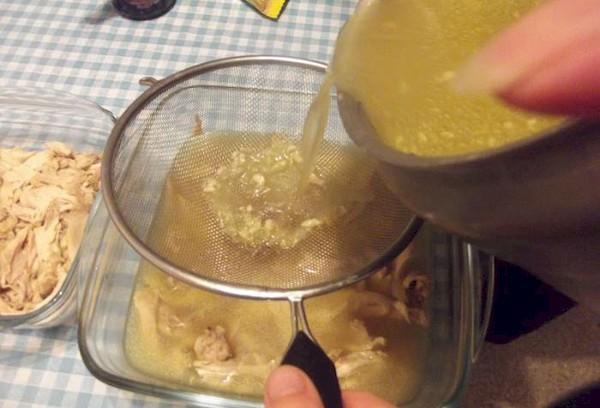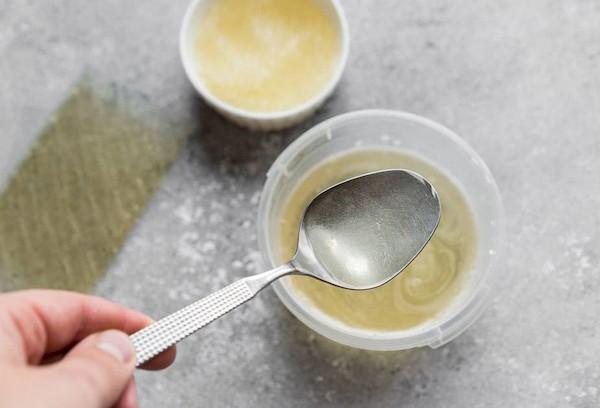How to properly dissolve gelatin for jellied meat
It’s worth starting with the fact that gelatin is not always needed in this dish. However, if you want to get a stable and elastic consistency, you still have to figure out how to add gelatin to jellied meat correctly. Housewives usually take 20 grams of granules (or 40 to make the jelly even denser) for each liter of broth.
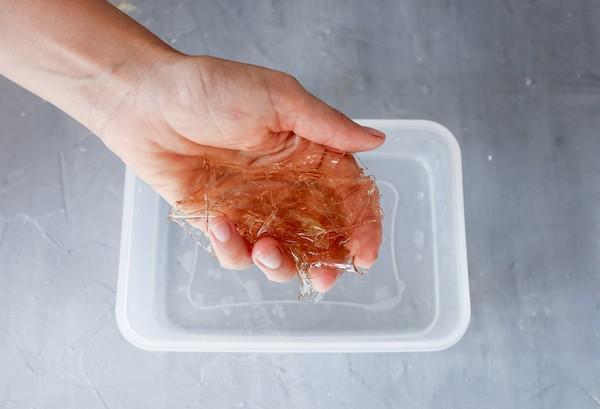
Then they add it using the following sequence of actions:
- Pour the granules into a glass and pour 0.2 liters of broth. It is important that the liquid is not too hot - after cooking it is worth letting it cool to room temperature.
- Stir the mixture and leave until all the granules swell. Typically this process takes from half an hour to an hour - the total time depends on the brand of edible gelatin.
- Warm up the resulting mixture a little. All granules should dissolve, the consistency should become liquid, and the color should be transparent.
- Gradually add the gelatin mixture to the rest of the broth, keeping it on low heat.
The subtlety is that the broth must be brought almost to the boiling point, without allowing it to completely boil, otherwise the gelatin will lose its properties. Also, during the cooking process, you may encounter some peculiarities, or even situations, when gelatin is not needed at all. Let's look at them below.
When gelatin is added to jellied meat
There are a great many recipes for jellied meat - probably every family can boast of its own experience in this matter. You can often come across the opinion that gelatin is superfluous in this dish. Indeed, properly selected bones and parts of the carcass themselves are capable of releasing a substance during cooking that helps thicken the broth. It’s just not easy to achieve the desired consistency this way. Let's figure out when it is necessary to add gelatin, and when you can do without it.
When is gelatin not needed?
If the jellied meat is made from enough bones, and the ingredients also include skin and cartilage, a natural thickener may be sufficient. However, in this case, the cooking process will take significantly longer. In order for the component to be released in the required quantities, the broth will have to be cooked for about 8 hours, or even more. This is not always possible.
Note! The minimum for cooking the correct broth is 6 hours. If you don’t have that much time to prepare the dish, it is better to use an alternative method.
Why add gelatin anyway?
Gelatin will come to the aid of the housewife in a situation where she is not sure that the broth can turn into jelly on its own. For example, if the basis of the jellied meat is mostly pure meat, the binding component will have nowhere to come from. However, some people do not like to use skin and cartilage in recipes.It is especially difficult if the dish is prepared from chicken or fish - then the broth itself will not harden at all. In this case, gelatin will be an excellent solution.
In addition, it can save you if the housewife has very little free time for cooking and needs to add something to make the jellied meat harden without boiling the broth for a long time. You will have to work with a natural thickener for at least 6 hours, and gelatin sets in a matter of minutes. So using a purchased analogue can be perceived as a way to speed up work.
Finally, there are times when the “right” jellied meat just doesn’t work out. Sometimes it is even difficult to determine the exact cause. If you don’t have time for experiments, you can immediately use gelatin. In this case, the desired result will be guaranteed if the correct amount of granules is placed.
How to properly dilute gelatin
In order for the use of gelatin to help improve the dish and not spoil it, the granules must be diluted correctly. There are two factors that can affect the quality of the finished product. The first is the ratio of components. If you do not take enough gelatin, the jellied meat will not harden and will remain too soft. But if you overdo it, you can end up with a jelly that is too dense and completely devoid of tenderness.
The second important indicator is the exact adherence to the correct sequence of actions. If you skip a step, or neglect the rules, lumps may remain in the thickener, which will ruin the texture of the dish. Let's look at each of the points step by step.
Methods for diluting gelatin
There are two ways to properly dilute gelatin for jellied meat.Both work equally well, so you should choose based on personal preference:
- Dilute with cool water.
- Dissolve immediately in broth.
First, let's take a closer look at the water option. Here is the exact sequence of actions that will help you achieve the best result:
- Pour the required amount of granules into a glass of cold water.
- Soak the mixture for about an hour until all the particles are completely swollen.
- Place the mixture in the microwave, set the power settings to minimum and heat for a few seconds.
- Open the door and evaluate the appearance - the liquid should become transparent, completely homogeneous, without separate fractions inside.
- If the desired effect is not achieved, warm it up a little more. You should not immediately expose it for a long time. The main thing in the process is not to overheat the gelatin.
- Pour the prepared solution into the broth without removing it from the heat and stir well.
In order to warm up the swollen gelatin, you can use other methods. A water bath is often used - this method prevents the liquid from boiling. However, you can simply heat the mixture in a saucepan or ladle.
Note! Do not allow water with gelatin to boil, otherwise the properties necessary for cooking will be lost. In this case, the broth simply will not thicken.
The version with broth is no more difficult to execute. Many housewives prefer it, since the meat liquid does not have to be diluted with water. For everything to work out correctly, you need:
- Pour a glass of the finished broth and cool it to room temperature.
- By analogy with water, dilute the granules with liquid and leave for an hour.
- After an hour, make sure that the gelatin has completely dissolved. If there are any fractions left, you can heat the mixture a little to get rid of them.
- Add the resulting mixture into the pan with the rest of the broth, stirring constantly.
Any of the methods leads to an ideal result, so you can choose based on your own convenience.
Proportions
But the question of proportions suitable for diluting gelatin for jellied meat is more subtle. Depending on how many grams of gelatin per 1 liter of broth will be used, you can get a different texture.
Most often, one of three options is used:
- 20 grams. In this way you can prepare the so-called “weak” jellied meat. It turns out very soft, shakes a lot on the spoon and literally melts in your mouth.
- 40 grams. The most average and standard option. Allows you to obtain meat jelly of medium elasticity.
- 60 grams. When using this amount of gelatin, you will get a very stable and fairly hard jellied meat. This is an excellent option for experimenting with shapes - this is the texture that can be designed in any way you like.
In general, there cannot be strict and unambiguous recommendations on this issue. You can experiment with different amounts of gelatin to see which option suits your taste best and, accordingly, how much gelatin you need. Or use the data above if you already have a good understanding of your preferences.
Questions and answers
If you want the jellied meat to harden faster, can you put it in the freezer?
Under no circumstances should you do this. During the freezing process, the gelatin will turn into crystals, and the final texture of the dish will be very far from the desired one.
What can cause gelatin to have an unpleasant odor?
This feature is most often characteristic of an expired product. If the expiration dates are normal, the storage conditions may have been violated.In any case, you should not use low-quality gelatin. A dish with such a component will turn out tasteless, and may not thicken at all.
What to do if the jellied meat is not frozen?
Sometimes it is not possible to correctly calculate the amount of thickener the first time and the jellied meat does not freeze as a result. There is no need to despair - the dish can still be saved. To do this, an additional portion of gelatin must be diluted with water in a ratio of 1 to 4. As soon as the granules swell, the mixture should also be heated in the microwave for about 40 seconds at minimum power.
This solution can be added directly to the bowl of unfrozen jellied meat. An additional dose of thickener will work and the jelly will be guaranteed. True, in this case it becomes more difficult to control the dosage, so the texture may become denser than usual.
What is better to choose - gelatin in granules or in plates?
Working with records requires a little more skill, so it is better to choose the granular option. It works no worse, and the process becomes much simpler. However, the plates swell much faster - in just 10 minutes. For some this may be a deciding factor.
